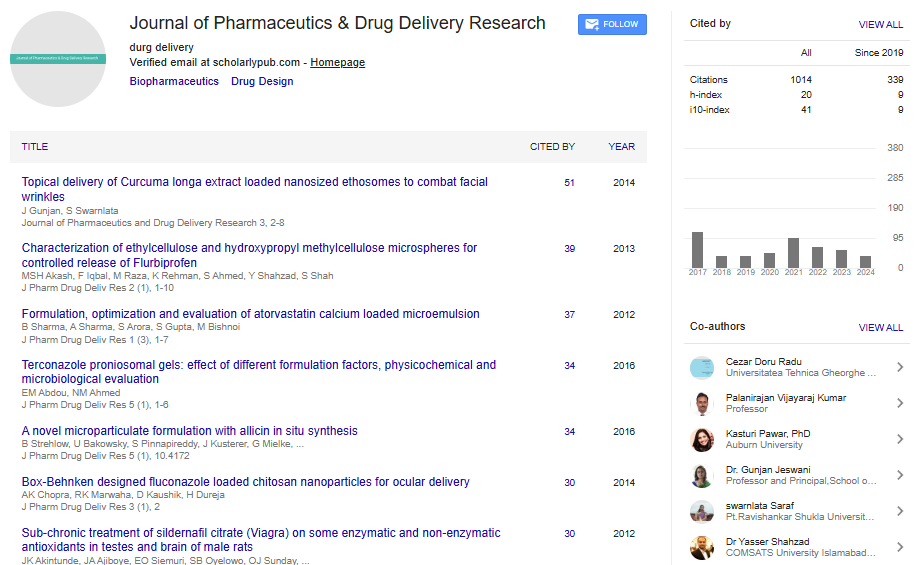Opinion Article, J Pharm Drug Deliv Res Vol: 13 Issue: 6
Advancements in Drug Delivery Systems: Enhancing Therapeutic Efficacy and Safety
Jiahua Ling*
1Department of Clinical Medicine, Zunyi Medical University, Zunyi, China
*Corresponding Author: Jiahua Ling,
Department of Clinical Medicine, Zunyi
Medical University, Zunyi, China
E-mail: lin.jiah@gmail.com
Received date: 28 October, 2024, Manuscript No. JPDDR-24-154131;
Editor assigned date: 30 October, 2024, PreQC No. JPDDR-24-154131 (PQ);
Reviewed date: 13 November, 2024, QC No. JPDDR-24-154131;
Revised date: 20 November, 2024, Manuscript No. JPDDR-24-154131 (R);
Published date: 29 November, 2024, DOI: 10.4172/2325-9604.1000310
Citation: Ling J (2024) Advancements in Drug Delivery Systems: Enhancing Therapeutic Efficacy and Safety. J Pharm Drug Deliv Res 13:6.
Description
Drug Delivery Systems (DDS) are an essential component of modern medicine, enabling the effective transport of therapeutic agents to target facilities throughout the body. These systems aim to improve the efficacy, safety and convenience of drugs while minimizing side effects. With advancements in science and technology, drug delivery methods have evolved significantly, further regular administration techniques to incorporate sophisticated systems that address specific challenges in healthcare.
Efficient drug delivery is essential for ensuring that therapeutic agents to achieve their intended effects. Without an effective delivery mechanism, drugs can change immediately, inability to reach their intended capacity or produce adverse reactions. For example, oral drugs frequently face challenges such as low bioavailability due to degradation in the gastrointestinal tract. Similarly, systemic administration can expose non-target tissues to the drug, leading to toxicity. Drug delivery systems address these challenges by enhancing drug stability, controlling the release rate and target particular areas within the body. These advancements reduce the required dosage, enhance therapeutic outcomes and improve patient compliance.
Traditional drug delivery methods
Historically, drugs have been administered through oral, topical and injectable paths. Each of these methods has different advantages along with drawbacks.
Oral administration: This is the most common and effective mechanism for administering medications. However, many drugs have low solubility, poor permeability or are susceptible to degradation by stomach acids and enzymes.
Injectable drugs: Medicines provide an immediate effect and are appropriate for medications that are poorly absorbed physically. However, they can cause pain, require professional administration and pose risks of infection.
Topical application: This method is suitable for localized treatment, such as skin conditions. Its limitation can be found in the inability to establish deeper tissues or systemic circulation effectively.
While these traditional methods have been effective, the requirement for improved accuracy and effective delivery has caused development in DDS.
Applications of modern drug delivery systems
Modern pharmaceuticals delivery methods are commonly utilized for the following applications.
Oncology: Cancer treatment has benefited significantly from advanced DDS. For example, Nanoparticle-based systems provide targeted delivery of chemotherapeutic drugs to cancers while decreasing systemic toxicity. Additionally, immunotherapy drugs can be delivered more effectively using ligand-targeted carriers.
Neurological disorders: The Blood-Brain Barrier (BBB) represents a significant challenge for treating neurological disorders. Nanotechnology-based DDS and focused ultrasound systems have demonstrated efficacy in delivering medications across the blood-brain barrier, improving treatment for conditions such as Alzheimer’s and Parkinson’s disease.
Infectious diseases: Advanced DDS play a significant role in preventing infectious diseases, especially antibiotic-resistant infections. Liposomal formulations of antibiotics enhance drug efficacy and reduce toxicity. Furthermore, sustained-release implants and improvements are being developed for long-term prophylaxis.
Chronic diseases: Conditions such as diabetes and cardiovascular diseases require long-term medication adherence. Controlled release systems and implantable devices provide sustained therapeutic effects, reducing the frequency of administration and improving patient compliance.
Gene therapy: Gene therapy is the process of transferring genetic material to cells in order to treat or prevent disease. Gene therapy is the procedure of introducing genetic material into cells to alleviate or prevent disease. Viral vectors and non-viral carriers, such as lipid nanoparticles, have emerged as effective tools for delivering nucleic acids, enabling developments in treating genetic disorders and certain cancers.
Modern drug delivery technologies
Common drug delivery technologies include. Controlled release systems are designed to deliver drugs at an established rate for a specified period. This approach maintains stable therapeutic levels while reducing dose frequency. Examples include: Drugs are embedded in a polymer matrix, which gradually releases the drug as it degrades or dissolves. These systems encapsulate the drug in a membrane that regulates release through diffusion or erosion.
 Spanish
Spanish  Chinese
Chinese  Russian
Russian  German
German  French
French  Japanese
Japanese  Portuguese
Portuguese  Hindi
Hindi 
